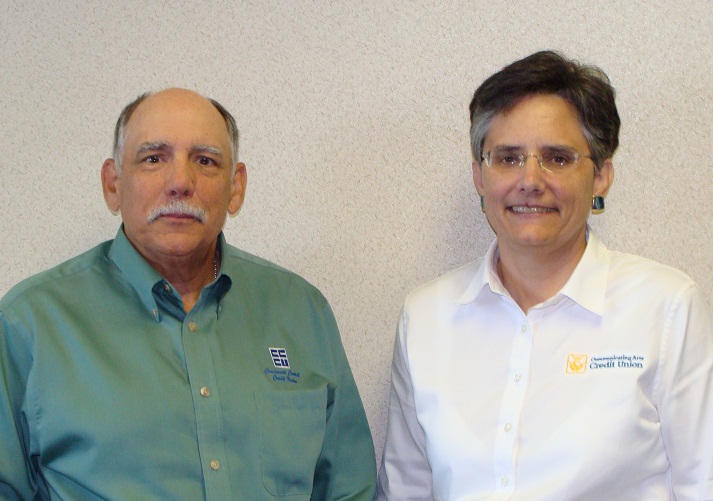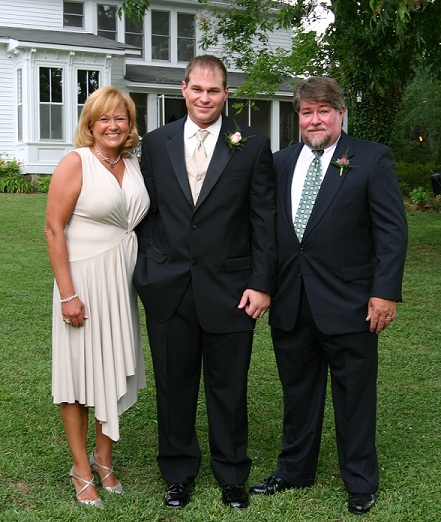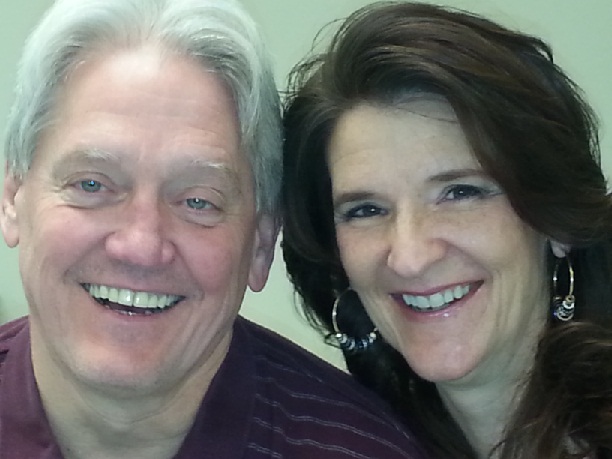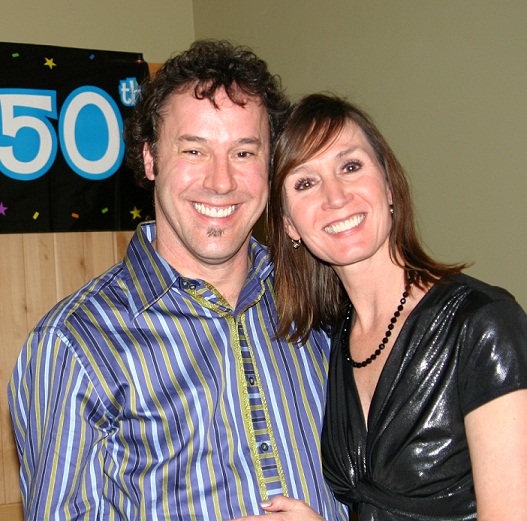Anyone who works in the credit union movement has experienced arange of successes, challenges, a few unforgettable moments.
|But are these experiences intensified even more amongcooperative professionals who have spouses or immediate family whoalso work in the credit union industry?
|Do husbands and wives, who are both CEOs with differentexecutive styles, argue when the inevitable dinner timeconversations turn to how should they manage problems at theshop?
|When a family of CEO executives talk business at familygatherings, do they get looks of boredom and confusion fromrelatives who know little or nothing about credit unions?
|Credit Union Times asked seven families to share theirinteresting and amusing insights about what life is like when thecredit union movement is all in the family.
|Read more: Meet the Woods …
||
 Art Wood and MaryOtt
Art Wood and MaryOtt
Husband-Wife CEOs
|At a credit union event in front of dozens of colleagues, ArtWood may have been one of the first credit union CEOs who made amarriage proposal to another CEO, Mary Ott.
|They met through the Florida CUES Council. So when Art decidedto propose, he thought it would be romantic to “take a knee” at aFlorida CUEs Council emergency board meeting. Or at least that'swhat Mary thought it was before she realized what was reallyhappening, and said yes in a roomful of teary-eyed colleagues.
|Hitched in 1998, Art, president/CEO of the $274 million Railroad & Industrial FCU in Tampa and Mary, president/CEOof the $82 million Florida West CU in Brandon, often joke that their marriageworks because their cooperatives don't compete for the samemembers.
|“We know many of the same people and have had the same friendsand colleagues for so long,” Mary said. “It's very enjoyablebecause we go to the same meetings, share a lot of work issues andkind of bounce ideas off each other. It works for us.”
|They've also learned to respect each other's management style,though sometimes it has generated lively discussions.
|“How I get the job done is definitely not the way he would getthe job done, but we are both successful,” Mary said.
|Art agrees, adding that he has learned to hold his tongue.
|“When Mary is managing something and she doesn't ask for myopinion, I don't volunteer it,” Art explained. “That is a hardthing to do. I honestly have learned quite a bit from justobserving how Mary does things, and that has helped meprofessionally.”
|Their years of hard work were recognized when they became thefirst and only couple in credit union history to win theprestigious Buck Levins Award, CUNA's highest honor for politicaladvocacy, in 2013.
|“Not in a million years did we ever think we would receive thataward,” Mary recalled. “We are really, really proud of that andvery happy to do what we can do on behalf of the credit unionmovement.”
|Read more: Meet the Herrings …
||
 Bill and CatherineHerring
Bill and CatherineHerring
Brother-Sister CEOs
|Bill Herring and his sister Catherine Herring had one of thebest credit union role models while they were growing up inCincinnati.
|Their mother, Louise McCarren-Herring, was one of the pioneerleaders of the credit union movement who co-founded the Ohio CreditUnion League in Columbus. She is also credited with establishing500 cooperatives.
|Because there wasn't always enough money for a hotel room, McCarren-Herring sometimes slept in her car as she wastraveling from city to city to organize credit unions, said Bill,president/CEO of the $91 million Cincinnati Central CreditUnion.
|The funny thing is, Bill and Catherine said they never thoughtabout pursuing credit union careers, even when helping mom withwork at cooperatives in their formative years.
|Bill was getting ready to graduate college and join the PeaceCorps in 1969 when his mom asked him to temporality manage Cincinnati Central CU.
|“I said I would do it until my application was processed andaccepted at the Peace Corps,” Bill said. “I never made it to thePeace Corp and I'm still here.”
|Catherine joined the $58 million Communicating Arts Credit Union in Cincinnati 40 years ago andbecame its president/CEO in 1987.
|“I didn't plan to have a career in credit unions. It just kindof happened,” Catherine reflected. “Mom needed help in the officeand I said I would help out, and it just kept going.”
|Over the years, brother and sister have collaborated, enablingthe Buckeye financial institutions to thrive.
|“More than 25 years ago, we both needed new space, so my creditunion constructed a building and my sister's credit union agreed torent space,” Bill said. “We've been in the same building since1987. We also jointly own a CUSO for data processing systems.”
|Additionally, the credit unions share a board room, employeelounge and training facilities.
|“We have somewhat different field of membership but there aresome areas of overlap,” Bill said. “In the areas we havecompetition, it's healthy competition and there is certainlynothing wrong with that.”
|Catherine agreed.
|“I don't think there is any way a credit union our size couldhave afforded on our own a new Symitar system when we got it backin 1999,” she said. “But by combining resources we were able to geta pretty robust system. We grew up seeing credit unions cooperatewith each other. It was just a part of everyday life for us, soit's not anything unusual to have a relationship like this forus.”
|Read more: Meet the Harrells …
||
 Daphne, Heath and MikeHarrell
Daphne, Heath and MikeHarrell
Mother-Son-Father CEOs
|As early as he can remember, Heath Harrell heard his mom anddad, Mike and Daphne, have amusing dinner table conversations aboutwhat happened during their daily work at their credit unions.
|Mike is president/CEO of the $139 million ACIPCO FCU in Birmingham, Ala., and Daphne is president/CEO ofthe $88 million Heritage South CU in Sylacauga, Ala.
|“It was pretty funny listening to them — and it still is knowingtheir different management styles — debate about who does what andwho is right or wrong,” said Heath, who is president/CEO of the$252 Guardian CU in Montgomery, Ala.
|“Sometimes they've tried to draw me into the debates,” hechuckled. “But it's just easier for me not to get involved.”
|Mike describes his management style as conservative whileDaphne's is just a little bit more liberal.
|He recalled discussing whether it was wise move for Daphne toconvert then-Avondale Employees Federal Credit Union into acommunity charter eight years ago. Though the Avondale (textile)Mills had been in operation for more than a century, the companywas struggling against crushing international competition. The conventional wisdom, however, was that the company wouldsomehow survive, Mike said.
|But Daphne had doubts and decided to apply for a communitycharter. She also invest in prime real estate next to a busyhighway for the credit union's future expansion.
|“Daphne, that's crazy. I wouldn't do that,” Mike told his wife.“Of course, she just went on as if she didn't hear what Isaid.”
|About six months after Daphne decided to secure a communitycharter, Avondale Mills shut down. About 4,000 people lost theirjobs.
|“If she had listened to me, she would be working for someoneelse,” Mike said.
|He also acknowledged that Daphne has been able to help him seethings in a different way, making him a better CEO.
|Heath believes growing up in a credit union family helped puthis career on the fast track. He became a CEO of Kamala CreditUnion when he was only 27, and later facilitated that cooperative'sconsolidation with Guardian Credit Union, becoming its CEO. Moreover, Heath's wife, Hillary, also broke into the credit unionbusiness in 2006 as a part-time consultant for Corporate AmericaCredit Union in Irondale, Ala.
|“It's been great having good role models in this industry tohelp me along,” Heath reflected. “They are a huge resource to mebecause combined they have over 60 years of experience. Anytime Ihave ideas, I bounce it off of them and they have been hugelysupportive.”
|Read more: Meet the Millers …
||
 Paula, Ryan and RickMiller
Paula, Ryan and RickMiller
Mother-Son-Father CEOs
|What's it like having a credit union family when the rest of theextended family doesn't know all that much about credit unions?
|Well, it's boring for the rest of the relatives who aren'tinvolved in the industry, laughed Paula Miller, senior vicepresident for the $398 million Legacy Community FCU in Birmingham, Ala.
|“At family gatherings, some relatives would say 'why do you alljust want to talk about credit unions,'” Paula said. “Even thoughwe love talking about credit unions, we have to think of otherthings to talk about.”
|Admittedly, Rick Miller, president/CEO of the $27 millionEnergen Credit Union in Birmingham, Ala., said it's reallydifficult not to talk about credit union business at familyget-togethers.
|“You get so caught up in the day-to-day involvement of runningthings and you don't have a lot of time to sit down andretrospect,” Rick explained. “When you get around other people whodo the same thing, then that's a good time to talk shop.”
|Sometimes they can't help but talk shop because their son, Ryan,at 22, recently became the president/CEO of the $7.2 millionBrassies Credit Union in Anniston, Ala.
|So to say the least, Ryan is asking a lot of questions.
|“We never encouraged him to go down the credit union path, perse,” said Paula. “But when he finished high school, he startedworking as a traveling teller for the $595 million Alabama TelcoCredit Union in Birmingham, and he really enjoyed it. He's a smartfella and he wants to be in charge. He's working very hard and I amexcited he has the opportunity at this age.”
|Read more: Meet the Whitties …
||
 Mike and Deb Whittie
Mike and Deb Whittie
Husband-Wife CEOs
|Mike and Deb Whittie at times feel they are perpetually at work,even when they are at home.
|Mike is president/CEO of the $18.5 million Federal EmployeesCredit Union in Des Moines, Iowa, and Deb president/CEO of the $9.3million Village Credit Union, also in Des Moines.
|“We manage two closed fields of membership, so we are not indirect competition with each other and our offices are locatedabout six blocks apart,” Mike said. “That makes life a littleeasier. I'm not sure what it would be like if we were incompetition with each other.”
|As CEOs of small credit unions that are facing enormouschallenges to stay competitive, Mike and Deb regularly tap intotheir cooperative spirit by leaning on each other for advice andsupport.
|“As CEOS, we spend our day solving problems and your staff isconstantly asking you questions,” he said. “At times, I'll call andask her a question and she'll call and ask me a question. We tendto be involved with each other's credit union and that can beoverwhelming.”
|Deb finds being married to a CEO has its advantages.
|“If there is something going on I don't know much about, I cantalk to him about it,” said Deb. “There have been times we havebeen behind in our work and we help each other out.”
|She started her credit union career path early, at age 14, atthe Des Moines Postal Credit Union, now the $65 million First ClassCredit Union in West Des Moines, where her dad and mom worked.
|There are times, however, when the Whitties don't talk aboutcertain things because they have different managementapproaches.
|“There are some things I don't bring up because I know hedoesn't do the things like I do, procedure-wise,” Deb said. “I am ashort-cut person and he's not.”
|Nonetheless, the differences in management styles are balancedout by a mutual understanding of their challenges in the workplaceand the marketplace.
|“When things are going bad for me, he understands why things aregoing bad,” she said. “I get what he is talking about and what hisday was like. I think it's beneficial to understand his work as heunderstands my world as well.”
|Read more: Meet the Jaremkos …
||
 Juliet and KyleJaremko
Juliet and KyleJaremko
Mother-Son CEO-Business DevelopmentSpecialist
|On snow days, Juliet Jaremko would bring her then elementaryschool aged son, Kyle, to work at the $12.5 million FairleighDickinson University Federal Credit Union in Madison, N.J., whereshe launched her credit union credit union career posting payrollentries, and later became a loan officer.
|“That was kind of his initiation into the industry,” saidJaremko, president/CEO of the $64 million Automatic Data ProcessingFederal Credit Union in Roseland, N.J.
|Kyle remembers those early days that made a lasting impressionon him about money and people.
|“It was my real introduction to money and how people managedtheir money,” Kyle said. “I think it got right into my blood.”
|During high school and college summer breaks, Kyle was employedas a credit union teller. He also worked in other departments,helping him build his knowledge about the cooperative business.
|Similarly, as Kyle was growing up, Juliet also carved her careerpath holding various positions. Prior to becoming president/CEO ofADPFCU in 2005, she worked as its credit card coordinator and thenas an accountant.
|“One of great things about the industry is that it allows youopportunities to gain a lot of knowledge and experience fromdifferent areas of the credit union business,” Juliet said.
|Jaremko was happy to expand her son's credit union knowledge bysometimes discussing industry news or trends, pointing him to CUNA,the NCUA, and the New Jersey Credit Union League to learn moreabout what interested most about the credit unionmovement.
|Kyle even enrolled in the same college his mother attended,Bloomsburg University of Pennsylvania. After graduating, hemoved to England and earned a master's degree in internationalbusiness from Sheffield Hallam University in South Yorkshire.
|When he returned home, Kyle admits his lifelong exposure tocredit unions influenced him to take his first job at ADPFCU as amember development manager. He now works as a business developmentspecialist for the $125 million Jersey Shore FCU in Northfield, N.J.
|“It seems that once you're in the credit union industry, you'rein it for life,” said Kyle. “But it's great to have someone in thefamily to bounce ideas off of that may help my credit union.”
|Read more: Meet the Blacks …
||
 Eddie Black-TracieKenyon
Eddie Black-TracieKenyon
Husband-Wife CEOs
|To have two CEOs under the same roof is both nice anddifficult.
|That's how the relationship dynamic is described by Eddie Black,president/CEO of the $21.7 million TricoCommunity FCU in Helena, Mont., and Tracie Kenyon,president/CEO of the Montana Credit Union League, also inHelena.
|They met during a CUSO event in Montana and have been marriedfor seven years.
|“It's nice to have someone who understands your (CEO) life,”Black said. “My second NCUA exam was scheduled during our vacation.Though I tried to reschedule it, Tracie understood completely thatI had to be at the credit union, so we postponed our vacation.”
|Kenyon agreed with her husband, but added that there are timesit's difficult when she and her husband are privy to informationthat they cannot share or talk about.
|“There are times we have gotten to the point where we can't havecertain conversations,” Kenyon said. “Thankfully, in ourrelationship there is a high degree of respect and trust both aspeople and as professionals.”
|That difficulty, however, is balanced by the fact that thecouple shares many of the same colleagues, making their social andprofessional lives all that more enjoyable.
|“The MCUL annual meeting is really a celebration of ourfriendships with our credit union colleagues from across the stateand that makes it fun,” Black explained. “There are times whenTracie has to attend a dinner with one of her members, and when Iget to attend as well, we've never had to deal with any awkwardspouse moments.”
Complete your profile to continue reading and get FREE access to CUTimes.com, part of your ALM digital membership.
Your access to unlimited CUTimes.com content isn’t changing.
Once you are an ALM digital member, you’ll receive:
- Critical CUTimes.com information including comprehensive product and service provider listings via the Marketplace Directory, CU Careers, resources from industry leaders, webcasts, and breaking news, analysis and more with our informative Newsletters.
- Exclusive discounts on ALM and CU Times events.
- Access to other award-winning ALM websites including Law.com and GlobeSt.com.
Already have an account? Sign In
© 2024 ALM Global, LLC, All Rights Reserved. Request academic re-use from www.copyright.com. All other uses, submit a request to [email protected]. For more information visit Asset & Logo Licensing.









